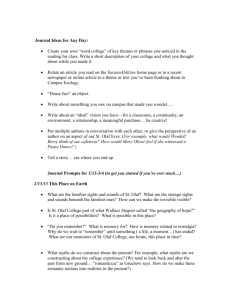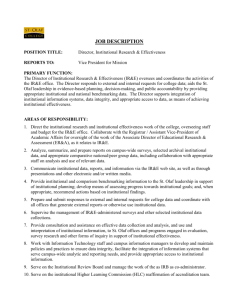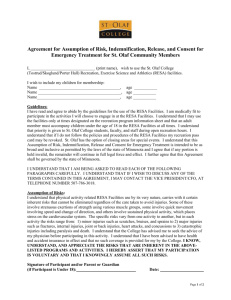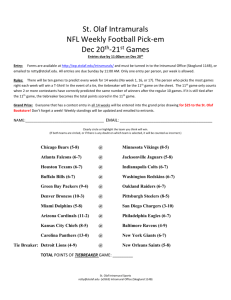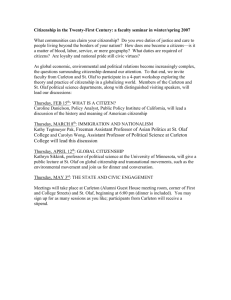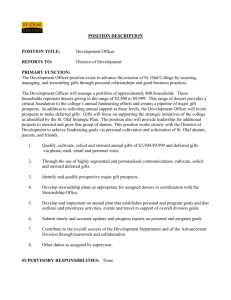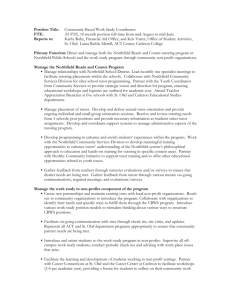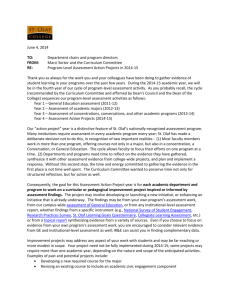Manifestations of Class at St
advertisement
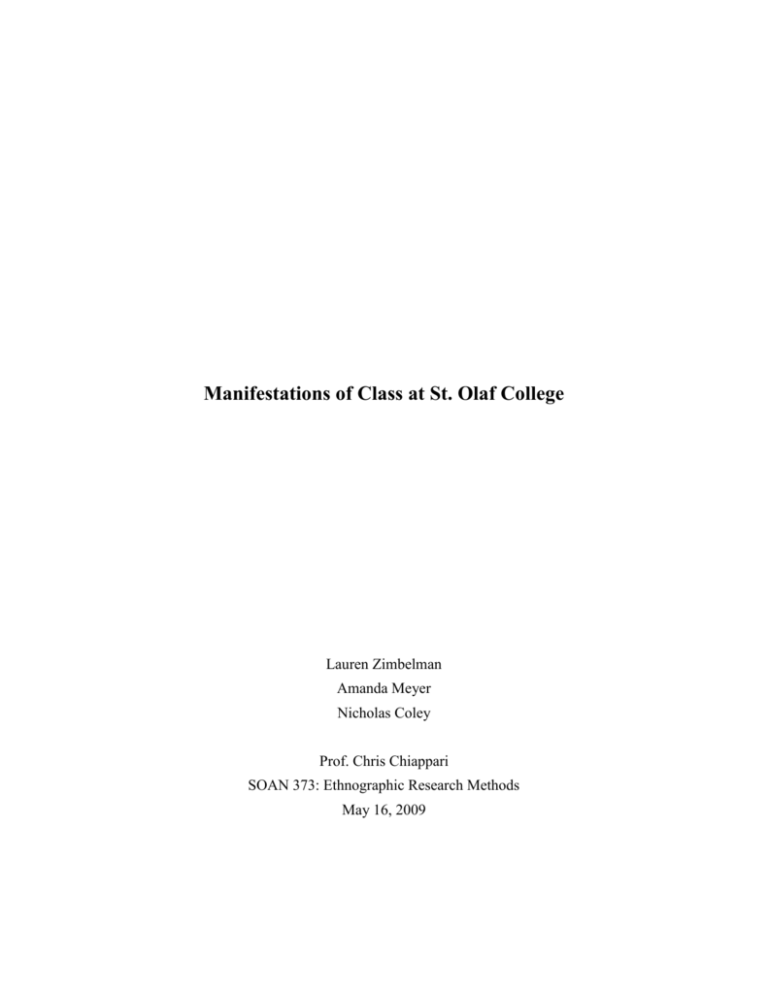
Manifestations of Class at St. Olaf College Lauren Zimbelman Amanda Meyer Nicholas Coley Prof. Chris Chiappari SOAN 373: Ethnographic Research Methods May 16, 2009 Executive Summary: Manifestations of Class at St. Olaf College Abstract Class is a particularly complex and difficult research; it is a sensitive and taboo subject in American society, but people hold diverse definitions and perspectives regarding class. Instead of attempting to define such an elusive concept, we have explored students' own perceptions of how class is manifested at St. Olaf College. As a largely residential campus with a required meal plan in the central cafeteria, such indicators of class as living quarters or diet are to some degree minimized, in a sense, controlled by college policy. Similarly, the generally homogenous appearance of students at St. Olaf and their range of experimentation with clothing and possessions render class somewhat ambiguous in students. We have explored the remaining, less tangible ways students interact with class on campus. We focused our research on the indicators of social class reported by students, how students react to class and financial differences, and how class plays a role in their daily lives and relationships. We found that many students were eager to discuss the topic in our focus groups and interviews, since discussing class was a rare experience. However, a portion of research participants were hesitant to approach the subject and continued to feel uncomfortable throughout our discussions. This irregularity in how students treat social class as a conversation topic prompted us to further examine it is such a taboo topic. Summary of Research Findings: Indicators According to Levels of Intimacy: Class indicators cited by students often depended on the intimacy of the interpersonal relationship, where superficial relationships highlighted personal appearance and certain material indicators, whereas closer relationships emphasized family background and more subtle indicators. 2 Family Background: Prominent class indicators include the location of a family’s home, parental occupations, or single versus two-parent households. Student Work: Not having a student work job shows a higher class background because students can pay for school without needing to earn money. Working in Stav Hall is linked with lower class perceptions because of the work’s undesirable conditions and public exposure. Students with high student work awards mentioned that the hours they spend on working take away from academic achievements and from their ability to take part in extracurricular activities. Tuition and Financial Aid - Hidden Costs: Students with less financial stability worry about and struggle to pay the hidden academic costs that are not addressed by financial aid such as the semi-annual $600 deposit, class and materials fees, and the cost of books. Appearance: Appearance is the first indicator a student uses to infer social class if they do not know another person. However, our respondents agreed that it is the most malleable class indicator and can actually function to render class on campus ambiguous. Students of a higher class mentioned the pressure to buy non-designer brands to appear less conspicuously wealthy and to avoid criticism from friends. Students of a lower class reported pressure to buy designer or brand items in order to fit in. Students from the middle class mention buying knock-off designer items and then feeling the need to defend the purchase by advertising that they didn't spend much money on them. Consumer Habits: Students of a higher class tend to stay updated on the latest technology and to have more material possessions like cars and electronics. They also seem to have less respect for material possessions, whereas lower income students treat their possessions with more care. Leisure, Vacation, and Travel: Leisure behaviors were often cited as class indicators – like going to bars and restaurants, as well as expensive vacations and travel, including study abroad. 3 Money Handling: Differences in attitudes towards money were mentioned as indicative of class, especially relating to spending priorities: necessities vs. fashion, and showing off wealth. Attitudes: Students make assumptions about intelligence, morals, values, and home life based on perceptions of class. Lower class students feel pressure to blend in, but don't often suffer open criticism as upper class students do. Upper class students sometimes receive criticism for their consumption habits, and are afforded less sympathy when dealing with issues not related to money. Criticism diminishes once students get to know each other better and become friends. Social Grouping: Students of similar class backgrounds tend to stay within the same social groups. This might be because students create friendships with those whom they meet early on and frequently encounter. The Student Support Services (SSS) program fosters isolated social networks for lower class student through its summer programs and continuing nature. Language: Language was not often cited as a class indicator at St. Olaf, except by students from non-English speaking families or from different dialect areas. This may be due to some students changing their language to match the norm, leading others not to perceive differences. Class in the Classroom: Class was mentioned in this context in that students who are of a perceived higher class are more comfortable speaking up in class discussions. Also, students made several comments about professors' assumptions that all students are from a middle-higher class. Students who felt they differed from this stereotype found this trend to be offensive. Race: Race was an important feature of class for only a few respondents, mainly for those who felt their class was judged based on their non-white race. Others reported a sense that they "fit in" on campus due to being white. Due to the limited nature of our project, race was only examined as it relates directly to class. 4 Abstract Class is a particularly complex and difficult research; it is a sensitive and taboo subject in American society, but people hold diverse definitions and perspectives regarding class. Instead of attempting to define such an elusive concept, we have explored students' own perceptions of how class is manifested at St. Olaf College. As a largely residential campus with a required meal plan in the central cafeteria, such indicators of class as living quarters or diet are to some degree minimized, in a sense, controlled by college policy. Similarly, the generally homogenous appearance of students at St. Olaf and their range of experimentation with clothing and possessions render class somewhat ambiguous in students. We have explored the remaining, less tangible ways students interact with class on campus. We focused our research on the indicators of social class reported by students, how students react to class and financial differences, and how class plays a role in their daily lives and relationships. We found that many students were eager to discuss the topic in our focus groups and interviews, since discussing class was a rare experience. However, a portion of research participants were hesitant to approach the subject and continued to feel uncomfortable throughout our discussions. This irregularity in how students treat social class as a conversation topic prompted us to further examine why it is such a taboo topic. 5 Introduction The concept of social class is an elusive subject, debated across disciplines. Walter Goldschmidt writes that "American society presents the enigma that despite great differentials in wealth, prestige and power, there are no clearly marked social classes" (Goldschmidt 1950:483). His review of the various attempts by anthropologists, psychologists, and sociologists to define social class concludes that there are four class groupings in American society - the elite, the middle class, the proletariat, and the laboring people. However, it is not possible to draw lines of distinction between these classes, and the American culture includes a denial of class, which prevents class from becoming strongly systematized (Goldschmidt 1950). Social class in America is a blurry, malleable system that lends itself to diverse definitions. The original definitions of class, such as those used by Marx and Weber, were economically relational terms such as “worker”, “debtor”, “creditor”, and “capitalist.” Many definitions however use nominal categories such as “lower”, “middle”, and “upper” which are ostensibly less economic in nature (Wright 2002). Attempts to concretely define class include the Index of Status Characteristics based on the theories of W. Lloyd Warner. It uses four characteristics to determine an individual's social status: occupation, source of income, house type and dwelling area (Goldschmidt 1950). Psychologist Raymond B Cattel attempted to get away from socio-economic indicators when he categorized American society into five classes: "upper," "upper middle," "middle," "lower middle," and "lower,” but was largely unsuccessful in doing so. Goldschmidt mentions that sociologists used material representations of status – “living studies” – which also approaches social stratification through wealth (Goldschmidt 1950). 6 It seems that anthropologists, psychologists, and sociologists alike tend to agree that social class in America is generally analyzed in terms of economic classes. During our own research, we did not offer participants a definition of social class. Instead we asked them to define the concept for themselves. Students mentioned: privilege vs. disadvantage; the range of freedom within daily life; ownership; “who has money and who doesn’t” and other references to socioeconomic class; hierarchy, income, home location, race/ethnicity, and material possessions. Similar to the theorists’ definitions, most of these definitions can be traced back to wealth. Setting/Problem St. Olaf College is a small, nationally ranked liberal arts college located in Northfield, Minnesota 35 miles south of Minneapolis/St. Paul. The 300-acre residential campus houses roughly 3,000 students with a student-faculty ratio of 13:1 (St. Olaf, 2009). St. Olaf is a 4-year residential college with fewer than 200 students living off campus per year, and all on-campus students share a common room and board plan. While the majority of students on campus are indeed of the middle to upper-middle classes, the campus does contain students from the whole spectrum of social class. St. Olaf's financial aid department meets "full demonstrated need" but includes "self-help" within that, such as loans and student work awards of varying amounts. Thus, despite the room and board plan, students come in with different financial obligations that, in some ways, shape their experiences at college and create differences among students with different class backgrounds. Students’ differences in class backgrounds provide them with different amounts of social, cultural, and symbolic capital which they can use to manipulate their status and perhaps their social class. 7 Bourdieu and Forms of Capital Pierre Bourdieu was a French sociologist who worked with the concepts of cultural, social, and symbolic capital and believed that someone is not defined by social class but by the amount of each form of capital he or she has. In this sense, social networks can be used to create inequality. Bourdieu theorized that the dominant persons in a complex society must monopolize the cultural capital and economic capital in order to firmly found and legitimize their primacy (Richardson 1986). Bourdieu said that cultural capital exists in three forms: "in the embodied state, i.e., in the form of long-lasting dispositions of the mind and body; in the objectified state, in the form of cultural goods… and in the institutionalized state" (Richardson 1986). He considers schools to be the vessels through which social hierarchies are advanced. "Not unlike the church in medieval society, the school supplies a sociodicy in action of the existing social order, a rationale for its inequities and the cognitive and moral basis for its conservation" (Richardson 1986:2). For example, one element of cultural capital is language. Bourdieu believes that language is closely related to social position; that accent, grammar, spelling, and style all confer social status and play a major role in social mobility. In the context of American society, students come to college to mold themselves into an image of higher social position. Students at St. Olaf must take writing classes and practice speaking in front of group, which demonstrates the weight given to self presentation by the college’s academic structure. Students entering St. Olaf possess these and other academic and social skills in various amounts, which creates uncertainty surrounding the degree to which these skills and behaviors relate to social class. Social capital is defined as "the aggregate of the actual or potential resources which are linked to... membership of a group" (Richardson 1986:51). Being a part of a group confers on 8 the member the collectively owned capital - or credentials - which allow them to gain more ground within the social system. At Olaf, one can consider whether students enter with existing social capital traits such as possessing strong family connections or having been admitted through the college’s Student Support Services program for first generation, minority, and disabled students. Alternatively, students cannot acquire some forms of social capital until they become part of the St. Olaf social environment through membership in sports, student organizations, or student government. We can thereby consider different students’ ability to gain social capital by examining the balance of student work, academia, free time, and homebased activities in order to understand the specific ways in which social class manifests itself and is created at St. Olaf. Bourdieu asserts that symbolic capital is complicated by the capacity for tangible symbolic capital to instantaneously change a person’s status in regards to capital. Other forms of capital must be established for longer time before they can benefit the individual (Richardson 1986). Symbolic capital can be translated into social capital (for greater benefits), but this requries directed care, attention, and effort by an individual. Examples of this include status and reputation, which are significant concerns of St. Olaf students as they create an interpersonal network to support them both at St. Olaf and following graduation. Symbolic capital such as material possessions and behavioral traits facilitate the creation of social capital such as friendship and campus leadership positions. To better understand social class at St. Olaf, we can explore the ways in which students approach creating social capital as well as any differences in these approaches are present across students of various social classes. Examining the fluidity of social class, Bourdieu believes individuals "select and build meaningful courses of action and thereby actively contribute to determining those very social 9 factors that move them" (Richardson 1986:4). This means that the stereotypes and constrictions of social class are both created by and can be broken by students. Social class difference exist even though they are not often discussed at St. Olaf, but Bourdieu’s theories imply that individual students can alter their own social class through their chosen courses of action. Additionally, this raises the possibility that facilitating more dialogue and awareness regarding social class would allow students to more actively define their social class and to alter existing social norms. Veblen on Conspicuous Consumption Thorstein Veblen was a Norwegian-American economist whose work focused on the behaviors and characteristics of the upper class in American capitalism. Veblen coined such terms as "conspicuous consumption" and "leisure class” which are still referred to by social theorists. Veblen’s work often attempted to show ways in which wealth and class were merely social phenomena, as is evident in his book ‘The Beginnings of Ownership’ when he points out that “all wealth is such only in society” (Spindler 2002: 29). His terms “leisure class” and “conspicuous consumption” serve as two main themes in his analysis of the behaviors and characteristics of the upper class within society. He uses the first term, “leisure class,” in reference to the upper class, as illustrated in his description of “the substantial canons of the leisure-class scheme of life” as “a conspicuous waste of time and a withdrawal from the industrial process” (Spindler 2002:40). Such behaviors include “wasting time” with hobbies including music, sports, learning dead languages and good manners (Spindler 2002:39). Neither is simply “wasting time” sufficient behavior for the leisure class—it is necessary to demonstrate such wasteful use of time through such knowledge of manners, prowess at music or sports, etc (McCormick 2006:106). While Veblen acknowledges that work 10 is held in low esteem, he also points out that new pressures of the industrial age compel even the leisure class to occasionally engage in “quasi-purposeful” activities like “social duties”, charity work, and artistic or scholarly pursuit (Spindler 2002:34). He takes on the university education under the heading of “scholarly pursuit,” particularly mentioning universities with a religious affiliation, which use doctrine and ritual to instill values of the leisure class—specifically such activities as initiation and graduation, caps and gowns, a high value placed on sports, etc. (Spindler 2002:40). In his book ‘The Higher Learning in America,’ Veblen suggests that while “knowledge for its own sake” is wasteful, increasingly, universities are also taking on characteristics of businesses, in which both students and professors are required to display wealth and leisure (Spindler 2002:52). Using the term “conspicuous consumption,” Veblen addresses a more tangible side of the consumption of the leisure class and their display of wealth, for example by focusing on women’s clothing. In his work titled ‘The Economic Theory of Women’s Dress’, Veblen declares that clothing’s “function is an index of the wealth of its wearer…since social respect or status is gained by the display of wasteful expenditure, the first principle of dress, therefore, is conspicuous expensiveness and another central principle is conspicuous waste” (Spindler 2002:31). Veblen also examines the pressure to “fit in” to the norms established by the leisure class, pointing out that , “On pain of forfeiting their good name and their self-respect in case of failure, they [the lower class] must conform to the accepted code, at least in appearance” (Spindler 2002:108). Social patterns of leisure, vacation, and even higher education touch on the theories of Thorstein Veblen, who referred to the upper class as the “leisure class,” and describes their behavior as “a conspicuous waste of time and a withdrawal from the industrial process.” Veblen 11 even includes higher education under the concept of a “waste of time” and suggests that it is again removes the higher classes from a need to work, at least temporarily. While Veblen has his own ideas about what is a “waste of time” in reference to the leisure class, could easily substitute going out to bars, and expensive vacations and travel as conspicuous pastimes of the so-called “leisure class.” Thesis The small number of students at St. Olaf College necessitates that students interact with others from various class backgrounds. The dynamics of these interactions, the degree to which students notice class differences, and the ways in which differences in class affect social life and academics demonstrate the presence and complexity of social class at St. Olaf, wherein class is determined both by background and by manipulatable social factors. Methods Our research used three methods: focus groups, individual interviews, and observing a public presentation. Our focus groups consisted of two sessions with six students each. There were twenty interviews in total, a few of which were follow-ups with members of a focus group. Focus group participants and interviewees came from our friends, acquaintances, and fellow students. We attempted to include students of both genders and with diverse class backgrounds; to ensure a representation of students from lower class backgrounds, we solicited volunteers from the Student Support Services (SSS) program for interviews. The SSS program consists of students with low income families, first generation college students, and special needs. While the six students who volunteered to be interviewed were not asked specifically which of the SSS criteria they met, often they discussed such issues without being specifically prompted. 12 We used a question sheet in the focus groups as well as in one-on-one interviews, but our interviewing technique included follow-up questions to help create free-flowing interviews and focus groups. Both the focus groups and interviews were confidential, and no recordings were produced. Focus groups proved especially helpful in measuring comfort level of students in discussing issues of class, as well as encouraging dialogue by those more comfortable speaking in group settings. Furthermore, because we were measuring perceptions and attitudes toward class, we did not attempt to gather any objective data from participants, such as income, family earnings, or financial dependence/independence. This approach also excluded a quantitative survey from our research. We examined their perceptions of the class status of their fellow students and how they conducted themselves in relation to class. We also avoided asking participants’ self-perceived class, although they often discussed it through relative statements and their descriptions of social situations. We also attended a public panel discussion put on by four SSS students entitled “Poverty at St. Olaf” as part of ‘Poverty Awareness Week’ on campus. The discussion mirrored many of the questions we used during focus groups and interviews, and so we included it in our research. Additionally, it is interesting to note that our interview questions underwent a process of improvement as the project progressed in an attempt to attain more information and put the interviewee at ease. For instance, in the beginning stages of the project, we asked interviewees to rank five close friends by class to see which indicators they used in making class judgments. Interviewees however displayed significant discomfort with the exercise regardless of the interview’s confidential nature; we therefore removed that portion of the interview. The 13 discomfort prompted us to examine why class is such a taboo topic in our later interviews, which yielded several very interesting ideas in addition to our original interview topics. Main Findings Indicators According to Levels of Intimacy In our interviews and focus groups, it quickly became clear that indicators of class among students at St. Olaf were strongly dependent on the level of social intimacy between students. Between students who had just met or had little social interaction, easily manipulated indicators such as clothing and mannerisms were used to determine the class, while closer friends tended to base their evaluation of class on more intimate details such as family background. While family background was mentioned in a few interviews and at the 'Poverty Awareness Week' panel, it was often not the focus of the interviewee, or was described in relation to a very close friend. This difference in class indicators according to social intimacy levels illustrates the complex nature of defining certain traits as indicators of one class or another, since the importance and validity of these traits are often but not always subjective to specific interpersonal interactions. Family Background As mentioned above, family background tended to be a class indicator in closer interpersonal relationships rather than superficial relationships as class is a topic which does not often surface in casual conversation. The location of a student's home was a commonly cited indicator of familial class; at St. Olaf, certain suburbs of Minneapolis/St. Paul, for instance Edina and Wayzata, strongly connote an upper-middle or upper class background, in contrast to students from the inner city. Family background is also linked to class through the professions of a student's parents, including whether or not the student's mother works outside of the home. 14 Typically, high-earning professions such as doctors, lawyers, and business executives were referred to as upper-middle class, with upper-class professions including top executives, business owners, and powerful politicians. Furthermore, during the 'Poverty Awareness Week' panel, students cited single-parent households as part of their class background. Overall, these familybased indicators were cited as apparent primarily in closer friendships but not in casual social interaction. Student Work One of the main indicators of social class students sited was student work. Because St. Olaf uses student work as a part of financial aid, students who do not have a work study job either do not receive financial aid (automatically indicating their financial background) or have an award but have chosen to pay that portion of tuition out of pocket because they either do not want to work or cannot find a job. If students have chosen not to work, their ability to make that decision tends also to indicate a somewhat higher class. We found that it is rare to deduce a student’s class based on the type of student work they do because of the wide variety of possible student work positions, many of which are “behindthe-scenes” and entail minimal on-the-job contact with other students. The exception to this however is cafeteria jobs. Nearly every student asked agreed that working in Stav Hall cafeteria can be an indicator of class. Working in the cafeteria is undesirable because work hours extend through meals, employees must to stand during their entire shift, the atmosphere in the cafeteria is often loud and crowded, and student workers have to interact with other students in a server/patron relationship. The job’s unpleasant nature implies that student cafeteria workers need the job, as opposed to other jobs like working in admissions or at the athletics center reception desk, which were viewed as optional due to their more pleasant conditions. Similarly, 15 the public “face time” inherent in the cafeteria jobs leaves student workers vulnerable to judgment by other students. One student who works in the Caf also mentioned that the required uniform restricts his clothing choice, and anyone who “knows what to look for” could tell instantly by his uniform that he works there. Several students mentioned they felt socially and academically inhibited – or handicapped – compared to their friends because of the hours they spend working, be it oncampus or off-campus. The need to make money to pay for school or other expenses uses up energy and time and can cause stress. Students said these handicaps could affect the quality of their academic work, the number of extracurricular organizations they could join, and their ability to develop professional resumes. For example, one history major reported that the quality of his papers depends heavily on the amount of time he can devote to research and that the quality of his academic performance is more limited than his classmates’ because he works 16 hours a week to make money. Students also mentioned that work hours conflicted with participation in volunteer activities, clubs, sports, and other extracurriculars, all things that enhance resumes and allow for a more “balanced” life. Similarly, several interviewees expressed concern that they can’t take unpaid internships for the summer that would benefit their resumes and enrich their college experiences because they have to find paid jobs. In these and other ways, students with fewer financial resources in college end up with fewer “social building blocks” at the end of their four years at St. Olaf, as their lack of economic capital translates to a lack of social and cultural capital. They spend their free time working, while many of their colleagues use their time to generate networks and develop resumes. 16 Tuition and Financial Aid - Hidden Costs The four students in the "What it's Like to be Poor at St. Olaf" panel for Poverty Action and Awareness Week extensively discussed the hidden financial costs of college that are not addressed by the financial aid packages St. Olaf awards. Such costs include expensive textbooks, classroom "materials fees" (common in art classes and theater classes), and the semiannual $600 deposit necessary before registration is allowed. These students said that these costs required them to plan and save money in advance, but that they were unexpected during their first year at college. They mentioned that their difficultly paying small fees like these often reinforced feelings of being lower class. Additionally, the added worry and stress surrounding paying these unanticipated costs can wear students out and affect how comfortable they feel spending money on non-necessary things. Appearance Initially, almost everyone we interviewed said that appearance - especially clothing - is a strong indicator of social class. Students linked expensive clothing, brand labels, and a broad stylish wardrobe to looking upper class. However, after further consideration, most also concluded that appearance is an ambiguous indicator of class because it is so easily changed. Many referenced the St. Olaf “uniform” – looking nice, but avoiding conspicuous labels – and said if a student could achieve that, then it would be difficult to tell someone’s social class. One student, agreeing with the uniform concept, added that he felt students who have cultivated a certain “look” – like hipster, preppy, hippie, sporty, emo, and formal – tend to be of a higher class because they have the time and money to spend on creating such an appearance, whereas the simple “t-shirt and jeans” look requires less effort. When asked about styles that are 17 inherently grungier, he said he felt many students spend time trying to look as if they didn’t spend time on their outfits. The discussion of brands and generics brought up several contradictions. Several students from higher income backgrounds said they tend to “dress down” in order to look less conspicuous by avoiding buying designer clothing that would label them as wealthy. In addition, anti-consumerism and anti-materialism was repeatedly characterized as trendy on campus, adding to the pressure not to prominently wear brand name clothing. On the other hand, lower class students mentioned that clothing was their ticket to a wealthier appearance. One student reported spending hundreds of dollars on nice clothes, even though he has considerable difficulty paying for tuition, in order to fit the dominant style of dress. According to him, fitting in is as important as simply looking good when buying and choosing clothing. However, the existence of knock-of designer items allows for a grey area between buying name brand and buying off-brand clothing. Middle class students report buying knock-off designer wallets, clothes, and accessories because they looked trendy, but then feeling the need to defend the purchases by advertising triumphantly, “I got this for $5!” or “I got this off the sale rack at Target!” This creates a situation where branded clothing is visible only to students who know how to identify subtle labels and clothing differences, so that students not accustomed to these types of clothes might not recognize the subtly-placed brand labels at all. Consumer Habits Similar to clothing, many people mentioned that consumption habits tend to indicate class. They cited both whether students have a car, the type of car students drive (if they own one), technology (cell phones, mp3 players, laptops, etc), and the contents of dorm rooms (TVs, futons, sound systems, and decorations). They all stressed, however, that the strongest indicator 18 was not owning these things, since many students would have at least some regardless of their financial status; rather, how people treated their possessions and “how fast they go through things” were more reliable indicators. Students said that someone of a higher class tends not to treasure their possessions as much as less wealthy students because replacement of such items is not an issue. Additionally, if a student can afford to stay updated on the latest electronics, it indicates a wealthy background. Conversely, students of a lower class tended to purposefully save up for new purchases and keep their possessions for a longer time. Leisure and Breaks Many students brought up going to bars, restaurants, the movies, and other leisure activities as indicative of a higher social class. Going out to eat was most frequently mentioned. In addition to frequency, behavior such as buying drinks for friends or going to trendy cafes and concerts were mentioned as displaying a higher class background. One student claimed that those of a higher class could afford to "go out to the bars three nights a week," while she had to make decisions about which night to join them. Multiple students also reported making excuses as to why they could not go out. For example, students said they sometimes claim they are busy with homework rather than directly telling their friends that they do not have enough money to go to a sporting event or to a movie. Students’ plans during breaks were also widely seen as a definite indicator of class. Lower income students reported staying on campus during breaks to avoid paying for transportation, needing to work during breaks, and also vacationing less or not at all. Vacations were commonly referenced, especially if they involved long plane flights, international travel, or second homes. Vacations for students of a relatively lower class often involved much more work around the house, an extra job, and less time to “just relax.” 19 Study Abroad Study abroad was another issue mentioned often by those who were unable to afford it. Often, interviewees mentioned the common sentiment at St. Olaf that “anybody can go abroad if he or she wants to.” Also, the assumption exists that a student’s reason for not studying abroad must be that he or she simply does not want to or cannot due to academic or extracurricular requirements. Rarely do students view not studying abroad as related to financial means, although interviewees discussing this topic said that this is in fact a large factor for many students. Additionally, certain programs such as Global Semester and the Terms in Asia/Middle East are widely known to be very expensive, and a few students noted this. One lower income student said his sister was able to go abroad using a departmental scholarship, and that he could have as well but did not want to. He stressed the fact that scholarships exist for opportunities like study abroad, but this requires students to actively seek financial support and do extra work. Money Handling Aside from specific leisure, vacation, and travel behaviors, many students from lower or middle income families mentioned the somewhat vague concept of “money handling.” Several interviewees, as well as two students in the focus groups mentioned sensing that higher class students “just spend money differently.” Multiple interviewees talked about how many students try to be subtle in spending their money, avoiding conspicuous consumption as not to be criticized for having too much money and to avoid creating divides with friends who don't have as much money. Material possessions clearly indicated a higher class, especially regarding the frequency with which students consume goods to keep up with fashion trends and upgrade possessions like cell phones and computers. 20 The difference between spending money on necessities versus leisure activities, possessions, and fashion was often mentioned. Students in the panel discussion recalled having to use the “spending money” from their work study for such necessities as fees for classes including field trips, materials fees, expensive books, toiletries and even shower sandals. Their more financially stable peers, however, are often allowed to spend their work study money on things like going out to the bars and movies. One student questioned the priorities of these students, asking rhetorically, “I don't see why people just spend all their money doin' [that]... like why you gotta by $130 shoes, ya know?” She went on to assert that she however has the priorities and savvy to live with less; “I know how to live with nothing,” she said. One story mentioned during an interview involved a student brandishing her mother’s credit card for what the interviewee deemed less-than-important expenses. The differences in parental financial support were clearly a source of discomfort and tension for several of the interviewees, showing that money handling is closely intertwined with the patterns and decisions parents make about what their students need to pay for. Attitudes towards Education One student felt that students from low-income families, first generation students, or nonnative English speakers tend to prioritize education, whereas students from higher class backgrounds view education as an entitlement. This difference in attitude towards education also affected the way in which students conceptualized their chances for academic success. Students with higher class backgrounds tended to assume that they would graduate. Students from lower class environments tended to view graduation as uncertain and as something they are working hard to achieve, often relating their efforts to graduate to their family backgrounds, especially if their parents did not attend college. 21 Attitudes towards Social Classes Our research found discrimination against students from both ends of the class spectrum, but this discrimination took very different form. Students tend to make assumptions about intelligence, values, and home life based on perceptions of class. As an example, students mentioned the idea that lower class students got into St. Olaf "on the diversity card" while students of upper class are "only here because they can pay for it." Students were careful to state that they know this isn't always the truth but that the assumption is there. Generally, it seems that lower class students receive less criticism than upper class students. Two students from financially well-off families reported specific confrontations they had early on at St. Olaf in which they were openly criticized for being rich. One female discussed learning from a friend that certain other students preferred not to spend time with her because of her relative wealth. She said this caused her to dress down for a long time before she decided she should be comfortable with her own image. The other student was told he couldn't complain about the tuition increase because his mother had given him designer jeans for Christmas. He mentioned that he shops at discounter racks and other bargain stores because of the guilt that came with that statement. He quoted his thoughts when shopping in reference to his friends' reactions to the money he spends on clothing: "Okay hopefully I won't get shit [from my friends] this time." The negative attitude towards students with money leads to the use of phrases such as "rich bitch," which not only denigrates upper class students but also associates the concept of wealth with the personality of a "bitch.” Several students mentioned concern over the tendency to discriminate against upper class students when it comes to problems that money can't solve. For example, a student in a focus group mentioned a well-off friend with mental health and emotional issues whose friends and 22 acquaintances often displayed the attitude of "go buy yourself some love" both directly to her and behind her back rather than supporting her. Students did mention, however, that the influence of social class and money issues in interpersonal interaction declined as they became closer friends with other students. When people know their friends well, they are either more comfortable discussing such issues or they become more tactful in dealing with know socioeconomic differences. Social Grouping It became apparent as our research progressed that students of similar class backgrounds tend to associate more with students of similar class backgrounds. Many SSS students suggested that they only hang out with SSS students because students of the same class background “understand” their experience. Many also mentioned how SSS functions to keep them connected; students reported forming tight friendships with other SSS students during the program's summer orientation programs before their first year. Students who started SSS later reported having friendship groups with greater class diversity. This indicates that students tend to make friends from the first groups they meet or the groups with which they spend the most time. These groups often form due to similar interests or behaviors, which in turn can depend on class background. SSS works hard to connect first generation and lower class students, but as a consequence they are more likely to form lasting friendship groups among themselves. This tendency could help to explain why many research participants mentioned not seeing lower class students on campus; in addition to purposefully blending into the dominant student culture, lower class students also seem more likely to be isolated due to class-based social networks. 23 Language Language habits was not generally mentioned in most interviews as an indicator of class at St. Olaf, but some students did view it as contributing to class perceptions. One interviewee mentioned that a broad vocabulary, proper diction, and few grammatical errors tend to be associated with upper classes, which is tied into the cycle of education. Two students from nonEnglish speaking families made a purposeful point of clearly and properly speaking, relating this to the level of respect they felt they would receive at college. Many students though said they didn’t notice any correlation between speech or language and a perceived class, even when asked, which may be due to the standardization tendencies reported by interviewees from backgrounds with different speech patterns. Class in the Classroom More significant in regards to speech was the observation that those of a perceived higher social class are more comfortable joining and leading discussions in classrooms. This was mentioned by a few students, such as one student who discussed her hesitation to speak up in a classroom because she feels like a minority and an outsider. As a lower income person of color, she doesn't feel a sufficient level of comfort in the classroom which would make her open to participating in academic discussions. She mentioned having discussed this topic with friends from minority backgrounds who said they felt the same. Some interviewees also suggested that lower class students felt less comfortable with professors, such as going to office hours, although it was unclear what the precise cause of this discomfort was. A widely cited issue in the classroom was the overwhelming assumption of upper-middle class status by professors. Several interviewees, as well as Poverty Awareness panelists suggested that upper-middle-class white was the "unmarked" category – that professors assumed 24 students to be from a higher class because of their attendance at St. Olaf or their race. They recalled that professors sometimes made remarks assuming their economic privilege which they found offensive. In reference to professors' assumption that all students are upper-middle class, one student stated, "Students here are pretty open. It’s the professors. And that's sad." Race Race and ethnicity were linked to class by some of our interviewees. The majority of interviewees however spoke only briefly about race or did not mention it at all. Two students referred to race as a much larger issue for them than class, as they feel race is often much more noticeable when first meeting someone. Another two students brought up the fact that they felt their ability to “fit in” and appear as the same race as most students on campus allowed them to succeed, in contrast to other students who were non-white who they said dealt with more assumptions about class based on their race. Due to the limited nature of our research, we did not extensively ask about race except as it directly related to class perceptions; it would however warrant further research in order to fully understand its implications at St. Olaf. Concluding Points Manipulatable Indicators Another main finding is that it was often difficult to quickly ascertain other students’ social class backgrounds. Clothing was almost universally cited as a class indicator, yet many interviewees also commented on the ease of purposefully dressing up or down to obscure one’s class background. St. Olaf includes many institutional policies which function to minimize the visibility of social class, including the standardized dorms and required meal plan. Because the college setting obscures some material indicators of social class which are predominant in 25 broader society, the St. Olaf environment does limit the ability of students to determine other students’ class backgrounds, a common theme throughout our investigation. The most effective indicators of class status tend to be apparent only once a closer social connection has been formed and students learn details about others’ lives which are not apparent in casual interaction. These factors include parents’ professions, the city or neighborhood of their home residence, their vacation habits and break plans, their family’s financial situation, their financial aid situation, and other similar circumstances. Material Realities and Attitudes Nevertheless, the reality of students’ lives means that the equalizing effects of affordable clothing, standardized dormitories and a common meal plan are often limited. Although students have equal access to all dormitories through the college’s randomized room draw process, it appears that room furnishings are one of the most telling indicators of a student’s social class background. Expensive items such as televisions, game consoles, sound systems, high quality couches and chairs, computers, and the quantity and quality of decorations all indicate a student’s financial means. Also, the ability for students to eat meals off-campus renders the common meal plan somewhat ineffective at diminishing the influence of class in students’ foodbased behaviors. Both the frequency and the cost of off-campus meals indicate how much money students have available. Eating at a restaurant or having food delivered displays that students are willing to forfeit a pre-paid cafeteria meal by paying for a more luxurious meal. Therefore, food behaviors outside of meal plan allotments display both a student’s financial ability and a student’s attitude toward the food in the cafeteria. Similar to prior research conducted by Aries and Seider (2005), St. Olaf students of limited financial means and students 26 from wealthy backgrounds reported greater awareness of these material class differences than students closer to the dominant upper-middle class background. Our research also found that the level of respect given to material necessities like food can be an indicator of social class, wherein students of higher class backgrounds do not appreciate and respect the food provided by the cafeteria. For example, one focus group extensively discussed a specific food fight which occurred in the cafeteria. Some students, characterized as seeming upper class by members of the focus group, participated in the food fight and showed disregard for the implications of wasting food, including the extra work required by cafeteria employees to clean up the mess. This attitude prompted others to strongly criticize them both in private conversation and in a public announcement one student made in the cafeteria. The idea that students with more money show less respect for food and others’ labor than do students from lower income backgrounds mirrored findings of Aries and Seider (2005), in which students from lower income families reported having more appreciation for their material privileges in addition to a sense of empathy with the service workers on campus. Social Indicators This incident also exemplifies how students use indicators of social class which are not material but rather are based around social factors. These include attitudes, language habits, race, perspectives on wealthy and poor students, ability to access professional networks, and other behavioral traits. Overall, our research participants viewed these in a much more irregular fashion; some participants emphasized features such as race or attitudes towards money and material goods, whereas other participants focused primarily on material and consumption-based indicators. Students tended to focus on indicators which they said had affected them specifically; for example, students of non-white ethnicity reported feeling that their race affected 27 how other students viewed them, and students with upper class backgrounds talked more at length about stereotypes towards upper class students. Economic, Social, and Cultural Capital Therefore, the Marxian model wherein class is related to control over the means of production can apply to our research through adding social and cultural capital to the role Marx defined for economic capital. The St. Olaf environment tends to be politically liberal with a strong focus on promoting social justice throughout the curriculum and public dialogues. In this setting social and cultural capital comes from academic performance, social interaction, and a general expression of a student’s pro-social-justice attitudes through that student’s consumer habits, academic activities, professional activities, and discourse style. This helps to explain the emphasis found across our research on changing one’s class image to match the prevailing mode of expression, which at St. Olaf deemphasizes conspicuous consumption but demands a display of a person’s general success. Social and cultural capital is therefore gained when students demonstrate academic success, a strong career path, and a commitment to the student body’s prevailing values regarding social issues. This leads to an interesting conclusion about the acquisition of social and cultural capital at St. Olaf. We can understand this topic by reviewing Weber’s analysis of the relationship between capital and status-based stratification: When the bases of the acquisition and distribution of goods are relatively stable, stratification by status is favored. Every technological repercussion and economic transformation threatens stratification by status and pushes the class situation into the foreground. Epochs and countries in which the naked class situation is of predominant 28 significance are regularly the periods of technical and economic transformations. (1978:938) Although the class situation is not directly thrust into the foreground of life at St. Olaf due to its taboo nature, the role of higher education in determining class in broader American society is quite important. Across our research we found students labeling certain tendencies as upper class which were strongly linked to education: intellectual-based political values, articulate communication, and professional success, to name a few. Seen in these terms, the St. Olaf environment does in fact implicitly highlight social class in the very nature of the institution, regardless of the amount of public dialogue granted to the topic. In a social environment with an emphasis on ideas and with near universal access to at least some conspicuous consumption, it is appropriate to replace Weber’s "technical repercussion" and "economic transformation" with the idea that the St. Olaf environment provides for the transformation of social and cultural capital. At St. Olaf the malleability of social and cultural capital and the ability of students to purposefully manipulate their own capital levels independent of economic background create a situation of flux and transformation. In contrast to traditional consumption models which emphasize economic capital, a college environment promotes changing of the self rather than acquiring material goods. Relating one’s personal image to environmental values, Michael Carolan (2005) writes, “The politically correct type of consumption is now that which is (supposedly) non-material and tied to the body… [which has] become especially attractive to those high-minded (and often quite “green”) elites who express deep concern for the environment. For ultimately it allows them to continue to seek status, and thus reinforce class distinctions, through consumption, but without appearing hypocritical and insincere in doing so” (p. 105). This example shows a changing attitude in 29 society wherein conspicuous consumption of sociocultural values and behaviors, more manipulatable than material consumption, is becoming a more influential form of capital. Relating these concepts of Bourdieu and Veblen back to Weber, the instability of a person's social and cultural capital leads to less emphasis on status-based class stratification and to an environment in which external class status is less visible at St. Olaf than in other social contexts like high school. Thus the unstable nature of acquiring social and cultural capital minimizes but still provides for the possibility of status-based class stratification (Wright 2002). The implication of this conclusion is readily apparent: if St. Olaf wishes to further minimize status hierarchies and create equal opportunities for all students to succeed, then creating an institutional environment with a focus on ductile forms of capital such as knowledge will limit stratification and foster a greater awareness of class diversity at St. Olaf. The Taboo of Social Class In addition to examining the indicators and roles of social class, our research also allows us to analyze the ways in which students conceptualize and discuss social class. A theme which became increasingly apparent throughout our research was an underlying discomfort with the discussion of class. Excepting students on the end of the class spectrum, students often avoided directly labeling themselves as belonging to a certain class, nor were they comfortable labeling their friends according to class. Students hesitated to assign class rankings to their friends, and some directly stated that they did not want to label their friends based on class. Noticing this discomfort early in our research, we changed our questions so that we did not ask our interviewees to label specific persons. Rather, we framed questions in terms of general attitudes at St. Olaf, which respondents seemed much more willing to discuss. Needing to abstractly frame how students judge class, even in a confidential interview setting, surprised us and caused 30 us to examine why this subject seemed so taboo. We then asked interviewees why this topic caused so much discomfort, which to intriguing conclusions about the true role of class at St. Olaf. The responses regarding why class seemed to include both personal feelings of guilt or shame and the desire not to cause these feelings in others. For example, one girl in a focus group said that her boyfriend is wealthy and that he suffers from guilt about his financial well-being. Additionally, she and her boyfriend have different patterns of worries, and they often find each others' worries to be trivial. Her boyfriend cannot understand why she would worry about money, and she cannot understand why he does not worry about money. This reinforced their desire not to discuss class, since they know that their opinions might diverge and cause them both to feel uncomfortable. Some students also mentioned not discussing money mainly because they didn't want "to make others feel bad.” This sentiment applied to interactions both with wealthy students and with lower income students regarding money-related situations, mainly when those students displayed a financial status different from the norm of “upper-middle class.” We generally found that discussing class was off-limits, and was perhaps even considered rude. As one student stated, "You just don't do it in polite company." Students a focus group mentioned directly called it a taboo subject; in their experience people only talk about class in structured situations, and even then many were not comfortable with the topic, similar to our direct observations in our interviews. They said that they carefully weigh what is acceptable to say and what is not, and that they worry about offending people or making unwarranted judgments based on social class. Most students said that they would only openly talk about class with their very good friends. Interestingly, they did mention that money has become a more prominent conversation topic due to the recent economic downturn. In spite of the economic 31 crisis however, the feelings of guilt and shame associated with talking about social class at St. Olaf seem to strongly and effectively stifle discussion of class in both academic and social contexts. Potential Uses for Research One primary way in which St. Olaf could use our research centers around the panel discussion; it signaled a turning point in our project when we realized the degree to which many students, ourselves included, were not aware of the true socioeconomic diversity at St. Olaf. The experiences described by the SSS students on the panel presented a much different perspective than we had encountered in our research up to that point, which, led us to specifically solicit interviews from other SSS students. One of these SSS students spoke about how the larger ‘Poverty Action Awareness Week’ was the first of its kind at St. Olaf. Aries and Seider (2005) write that “for low income students to move from the margins and to become fully integrated into elite colleges and universities, those institutions may need to nurture and support working-class-based clubs or organizations, in the same way that they have fostered the development of similar groups based on gender, sexual orientation, ethnicity and race. Beyond that, institutions of higher education must create a climate where class can be acknowledged and openly discussed” (p. 441). Our research suggests that a similar situation exists at St. Olaf. This highlights how research on class at St. Olaf can serve as a starting point for campus dialogues. It demonstrates the reality and heterogeneity of class at St. Olaf, as well as the ways in which the lack of class dialogue cause discomfort and even conflict. We believe that more events relating to economic diversity will be helpful in raising awareness of the variety of perspectives held across the student body. Additionally, we hope an increased awareness of class will allow students to be more open about their own 32 experiences with class, reducing the discomfort surrounding differences in class between students and fostering honest communication about money and finances. Similarly, we found that students from lower class backgrounds felt less comfortable and often excluded in the classroom. Students described situations in which professors made sweeping statements referring to all students at St. Olaf as being upper-middle class, wealthy, or privileged. Our research shows many students do not feel that they fit such descriptions. This finding can help remind professors to always account for the various forms of diversity present in their classrooms and to take steps such as randomly assigning groups which increase the interaction between students of different backgrounds. Limitations and Future Research Because our project was limited both by time and by approach (focusing on qualitative research), we were not able to add a survey section to our project. Anonymous surveys may be useful in gathering more sincere information regarding sensitive topics like class judgments than information divulged in interviews. Furthermore, we could have included questions indicating interviewees’ class status, such as asking their parents’ occupations, perceived class status, financial dependence/independence, and clothing styles. Some interviewees voluntarily mentioned these factors, but it was not reliably addressed between interviews. Also, the responses to many of our questions appeared to differ according to gender. The response differed most in reference to whether or not class was an issue on campus, with several of the males and virtually none of the females responding in the negative. While we theorized within our group that females may have more outlets for expression of class in aspects of dress and pastimes, this was merely conjecture. One student in a focus group, however claimed that his group of friends had never had tension based on class because "We eat pizza, we play 33 videogames. That's all we do." Again, further research might specifically examine how gender differences affect class indicators, perceptions, and attitudes. Our research was limited by our timeframe to a limited number of focus groups and interviews. We slightly overrepresented juniors and seniors by interviewing our own acquaintances, and our attempt to include students from a wide variety of class backgrounds was often guesswork since we often did not know our interviewees’ class in advance. Many of our research participants were similar to ourselves, which limited the perspectives we could include. Further research could certainly make efforts to include participants from a broader range of socioeconomic backgrounds. 34 Bibliography Aries, Elizabeth, and Maynard Seider. 2005. "The Interactive Relationship Between Class Identity and the College Experience: The Case of Lower Income Students." Qualitative Sociology 28(4):419-443. Retrieved May 14, 2009 <http://search.ebscohost.com/login.aspx?direct=true&db=aph&AN=19076666&site=ehost-live>. Carolan, Michael S. 2005. "The Conspicuous Body: Capitalism, Consumerism, Class and Consumption." Worldviews: Environment Culture Religion 9(1):82-111. Retrieved May 13, 2009 (http://search.ebscohost.com/login.aspx?direct=true&db=aph&AN=16717104&site=ehost-live) Goldschmidt, Walter.1950. "Social Class in America - A Critical Review." American Anthropologist 52:4. Retrieved May 5, 2009 (http://www.jstor.org/stable/664207). McCormic, Ken. 2006. Veblen in Plain English. New York: Cambria Press. Poverty Action and Awareness Week. 2009. "Being Poor at St. Olaf Panel Discussion." Attended April 21, 2009. Richardson, J.E.. 1986 Handbook of Theory of Research for the Sociology of Education. New York: Greenwood Press. Spindler, Michael. 2002. Veblen & Modern America. London: Pluto Press. St. Olaf College. 2009. "About St. Olaf." Northfield, MN: St. Olaf College. Retrieved May 9, 2009 (http://www.stolaf.edu/about/). Weber, Max. 1978. Economy and Society, edited by Guenther Roth and Claus Wittich. Berkeley, CA: University of California Press. Wright, Erik O. 2002. “The Shadow of Exploitation in Weber's Class Analysis.” American Sociological Review, 67(6):832-853. Retrieved May 13, 2009 (http://www.jstor.org/stable/3088972) 35
